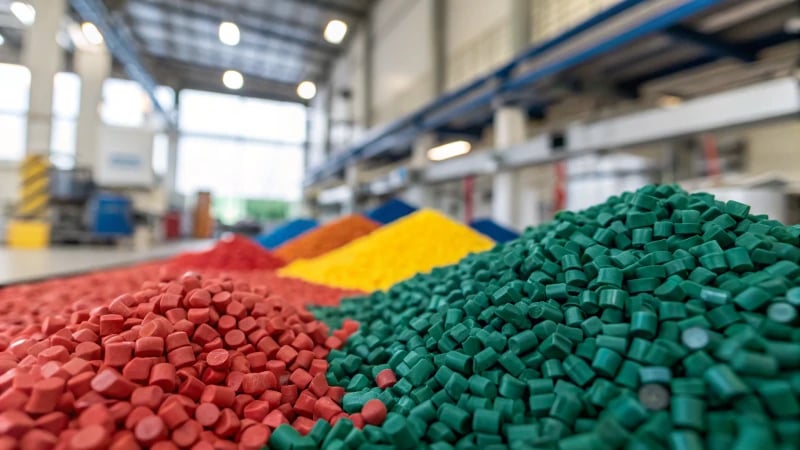
Ever wondered how to make sustainable manufacturing choices without compromising quality?
When using recycled plastics for injection molding, prioritize the material’s quality and compatibility, check for contaminants, and assess their impact on mechanical properties to ensure product integrity and cost-effectiveness.
Diving into the world of recycled plastics, I remember the first time I faced the challenge of integrating them into my designs. It felt like stepping into uncharted territory, full of potential but also fraught with obstacles. But I was determined to make it work. Beyond just knowing the basics, I had to dig deeper into understanding each material’s quirks and how they meshed with our existing processes.
In my journey, I’ve learned that testing small batches can reveal a lot about how these materials behave under pressure—literally. The path wasn’t always smooth, but with each trial, I got closer to achieving that sweet spot where sustainability meets functionality. Join me as I share insights and tips that have been invaluable on this journey.
Recycled plastics always maintain original mechanical properties.False
Recycled plastics can have altered mechanical properties due to degradation.
Contaminants in recycled plastics affect product quality.True
Contaminants can compromise the integrity and performance of molded products.
How Does the Quality of Recycled Plastics Affect Molding?
Ever wondered how the quality of recycled plastics can make or break the molding process? Dive in with me as we uncover the intricate dance between sustainability and production efficiency.
The quality of recycled plastics affects molding by altering melt flow, tensile strength, and consistency, impacting processing ease and final product integrity.

Understanding Material Properties
Let me take you on a journey through the world of recycled plastics and their mysterious properties. Imagine standing in a busy recycling plant, where heaps of colorful plastic await transformation. The quality of these recycled plastics is like a puzzle, influenced by where they come from and how they’re processed. Think of factors like melt flow index1, tensile strength, and contamination levels as pieces of this puzzle. A high melt flow index can make processing a breeze but might leave you with weaker mechanical properties. It’s like baking a cake—too much sugar might make it deliciously soft but structurally fragile. Maintaining consistent quality ensures that your molding outcomes are as predictable as a well-tested recipe.
Challenges in Using Recycled Plastics
Now, imagine you’re mid-project, and suddenly, those pesky impurities in recycled plastics rear their ugly heads. These impurities can mess with your machinery, clogging it like an old drain, or they might cause your beautifully designed products to warp or crack—like cookies baked without enough flour. Before diving into the molding process, it’s crucial to have a thorough pre-processing stage to ensure a clean feedstock2. It’s the equivalent of sifting through flour to avoid lumps in your batter.
The Impact on Product Design
As a designer, I’ve faced the creative challenge of incorporating recycled materials into products. It’s like adapting a recipe for a new diet—ensuring it still tastes great while meeting new health standards. With recycled plastics, designers must adjust mold designs to accommodate varying shrinkage rates or reinforce sections that might bear stress. Collaborating closely with material scientists can be like having a seasoned chef by your side, helping tailor solutions that optimize performance and sustainability3.
Practical Solutions for Manufacturers
Manufacturers often find themselves at a crossroads when integrating recycled plastics. It’s like deciding whether to make a cake from scratch or use a mix. Some opt for blending recycled with virgin materials to boost strength and durability. Regular testing and quality assessments become the baker’s trials to maintain high standards. Implementing robust quality control processes ensures that recycled plastics meet desired specifications consistently.
Example Table: Comparison of Virgin vs. Recycled Plastic Properties
| Property | Virgin Plastic | Recycled Plastic |
|---|---|---|
| Melt Flow Index | Lower | Variable |
| Tensile Strength | Higher | Lower |
| Consistency | High | Variable |
| Cost | Higher | Lower |
Exploring these aspects shows just how crucial it is for designers and manufacturers to fully understand and adapt to the nuances of recycled plastics. This isn’t just about keeping up with trends—it’s about embracing innovation and sustainability as allies in molding processes. And who knows? Along the way, we might just redefine what ‘quality’ means in our industry.
High melt flow index reduces mechanical properties.True
A high melt flow index indicates easier processing but often compromises mechanical strength.
Recycled plastics have higher tensile strength than virgin plastics.False
Recycled plastics typically have lower tensile strength compared to virgin materials.
What Are the Common Challenges in Using Recycled Materials?
Ever tried to build a dream project only to stumble over the hurdles of using recycled materials? That’s exactly what happened to me, and it was an eye-opener.
Recycled materials face challenges such as quality variability, contamination, higher costs, and limited availability, requiring advanced sorting and processing technologies to address these issues.

Variability in Material Quality
I remember the first time I tried incorporating recycled materials into my designs. The idea sounded perfect—eco-friendly and innovative. But then reality hit. The variability in material quality was like trying to solve a puzzle where the pieces didn’t quite fit. Recycled materials often varied in strength and durability compared to their virgin counterparts. This was especially problematic for precision components in electronics, where consistency is key.
| Material | Virgin Quality | Recycled Quality |
|---|---|---|
| Plastic | High | Variable |
| Metal | Consistent | Less Consistent |
To navigate this, many companies, including mine, are investing in advanced sorting technologies4 to ensure more reliable quality control.
Contamination Concerns
On another occasion, I was working with recycled plastics and noticed that they had an odd color and texture. It turns out they were contaminated with residuals from previous uses. This contamination can seriously compromise the integrity of materials. It’s like cooking with spoiled ingredients—you just can’t get the result you want.
Efforts are being made to improve cleaning processes; however, these improvements often lead to increased costs. We’re actively researching innovative cleaning methods5 to tackle this issue without breaking the bank.
Economic Viability
I’ve often faced the economic challenge of justifying the use of recycled materials. The additional processing required can make them more expensive than new ones. It feels like a catch-22—investing more upfront for potential long-term sustainability benefits.
A detailed cost analysis usually shows that these benefits can indeed outweigh the initial expenses if you play your cards right. This approach demands strategic planning and close collaboration with our supply chain partners6.
Limited Availability
And then there’s the issue of limited availability. It’s frustrating when not all regions have access to high-quality recycled resources, making sourcing a logistical nightmare.
This is why many organizations, including mine, are focusing on building better networks and sourcing strategies. Developing global supply chains7 is crucial for overcoming this limitation and ensuring a consistent material supply.
Each challenge presents an opportunity to innovate and improve how we integrate recycled materials into our designs. And while it may be tough, I believe it’s worth it for the promise of a more sustainable future.
Recycled materials have consistent quality like virgin materials.False
Recycled materials often show variability in quality compared to virgin ones.
Using recycled materials is cheaper than virgin materials.False
Recycled materials often incur higher costs due to additional processing.
What Design Adjustments Are Necessary for Recycled Plastics?
Ever wondered how to make recycled plastics work in your designs? Let’s explore the tweaks that can turn these eco-friendly materials into high-quality products.
Designing with recycled plastics involves adapting material choices, ensuring tolerance flexibility, and enhancing surface finishes to maintain quality and recyclability.

Material Selection and Compatibility
When I first started working with recycled plastics, choosing the right material felt like picking a needle from a haystack. Each type of plastic brings its own quirks, much like trying to choose the right pet from a shelter full of adorable faces. Take PET8 for example—great for bottles but if you’re thinking about using it for electronics, you might need to add stabilizers to avoid unexpected hiccups down the road.
Tolerance Considerations
I remember the first time I encountered the unpredictable nature of recycled plastics. It was like baking without measuring ingredients—sometimes it just didn’t rise the way you expected. Recycled materials can vary, so allowing for more generous tolerances can help avoid structural surprises. Understanding these variations9 is a bit like learning to dance in the rain—it’s all about embracing the unpredictability.
Surface Finish Optimization
Achieving that perfect, glossy finish can be like trying to iron a shirt without an iron. Impurities in recycled materials often mean rethinking finishing techniques. I’ve found that alternative methods or coatings not only mask these little imperfections but also keep the product in line with recyclability goals. Trying out alternative finishes10 can be like finding a hidden gem at a thrift store—unexpectedly delightful!
Structural Reinforcement
Incorporating ribs or gussets reminds me of adding extra stitching to a favorite pair of jeans. It’s all about adding strength without bulk. This approach not only maintains the product’s integrity but also aligns with sustainability goals11 by minimizing material use.
Use of Additives
Additives are like the secret spices in my grandmother’s soup—used sparingly, they transform everything. They can boost properties such as UV resistance or color consistency, but it’s crucial to strike the right balance. Researching additives12 ensures we enhance the product without compromising its eco-friendly nature.
Table: Key Design Considerations for Recycled Plastics
| Consideration | Description |
|---|---|
| Material Selection | Choosing the right recycled plastic based on properties and end-use. |
| Tolerance Adjustments | Allowing greater tolerance ranges to account for material variability. |
| Surface Finish Techniques | Using techniques that accommodate impurities and enhance recyclability. |
| Structural Reinforcement | Incorporating features that strengthen without adding excess weight. |
| Additive Use | Balancing additives to maintain recyclability and meet product specifications. |
Designing with recycled plastics is a bit like crafting a new recipe—you experiment, learn from each attempt, and ultimately create something sustainable and satisfying. By understanding these key considerations, we can all contribute a little more to our planet while still creating exceptional products.
Recycled PET requires stabilizers for electronics use.True
PET's properties change when repurposed, needing stabilizers for durability.
Additives in recycled plastics always reduce recyclability.False
Careful additive selection can maintain recyclability while enhancing properties.
How Do Recycled Plastics Impact Environmental Sustainability?
As I dive into the world of recycled plastics, I’m struck by their potential to reshape our planet’s future. How exactly do these materials contribute to environmental sustainability?
Recycled plastics enhance environmental sustainability by minimizing landfill waste, conserving energy, reducing greenhouse gas emissions, promoting a circular economy, and improving resource efficiency.

The Role of Recycled Plastics in Waste Reduction
I remember visiting a landfill once, and it was like a mountain of discarded dreams. Seeing how recycling can transform that waste into something useful really hits home. By converting plastic waste into reusable materials, recycling not only lessens the strain on our overflowing landfills but also helps protect our oceans and natural habitats.
Energy Conservation Benefits
When I first learned about the energy savings of using recycled plastics, I was amazed. Imagine this: creating products from recycled PET bottles13 can save up to 60% of the energy needed for new bottles. That’s like turning off the lights in a skyscraper for hours! Here’s a quick look at energy savings:
| Material | Energy Savings |
|---|---|
| PET | 60% |
| HDPE | 50% |
Reduction in Greenhouse Gas Emissions
The journey of plastics from cradle to grave is a major contributor to greenhouse gases. Recycling helps cut down these emissions by reducing the need for new raw materials, which means fewer pollutants from extraction and processing. This is a crucial step in tackling climate change, something I’ve grown more passionate about as I’ve seen its effects firsthand.
Challenges and Innovations in Plastic Recycling
Yet, it’s not all smooth sailing. Challenges like contamination of recycled materials and limited recycling infrastructure persist. However, I find hope in innovations like chemical recycling14 and advanced sorting technologies that aim to overcome these hurdles.
Being involved in product design, I see firsthand how industries can integrate recycled plastics into their production. Companies in my field are uniquely positioned to set trends by incorporating sustainable practices into designs and material choices.
Promoting a Circular Economy
The idea of a circular economy has always fascinated me — a system where nothing is wasted, and everything is reused. Effective recycling systems are key to this vision. By supporting policies that encourage recycling, we can push for a future that’s not just sustainable but thriving.
Engaging with initiatives and learning from successful models empowers both individuals and businesses to make informed decisions prioritizing environmental health. Exploring circular economy models15 has broadened my understanding of their profound benefits.
Recycled plastics reduce oceanic plastic waste by 50%.False
While recycled plastics reduce waste, exact percentage reduction in oceans isn't specified.
Producing PET bottles from recycled content saves 60% energy.True
Manufacturing PET bottles from recycled materials saves up to 60% of energy.
Conclusion
Consider quality, compatibility, and contamination when using recycled plastics in injection molding to ensure product integrity and sustainability while navigating challenges in material properties and processing.
-
Understanding melt flow index helps assess how easily recycled plastics can be processed during molding. ↩
-
Ensuring a clean feedstock improves the quality of recycled plastics and reduces contamination issues. ↩
-
Balancing performance with sustainability is key to optimizing product design using recycled materials. ↩
-
Exploring advanced sorting technologies can help improve the quality control of recycled materials, ensuring consistency and reliability. ↩
-
Learning about innovative cleaning methods can offer solutions to contamination issues, ensuring better quality recycled materials. ↩
-
Collaborating with supply chain partners can optimize costs and enhance the economic viability of using recycled materials. ↩
-
Understanding global supply chain strategies can aid in overcoming regional availability challenges of recycled materials. ↩
-
Explores PET’s characteristics, aiding designers in selecting appropriate recycled materials. ↩
-
Provides insights into managing material variations for structural integrity. ↩
-
Discusses ways to improve surface quality without compromising recyclability. ↩
-
Highlights design features that enhance strength while supporting sustainability. ↩
-
Informs about additives that maintain recyclability and desired properties. ↩
-
Discover how energy-efficient it is to recycle PET bottles instead of using new materials, offering significant environmental benefits. ↩
-
Learn about chemical recycling, an innovative process that enhances the efficiency and effectiveness of recycling plastics. ↩
-
Explore successful circular economy models that effectively reduce waste and optimize resource use, offering insights into sustainable practices. ↩






